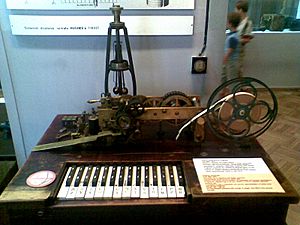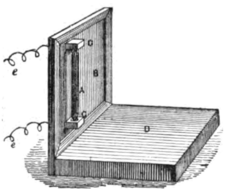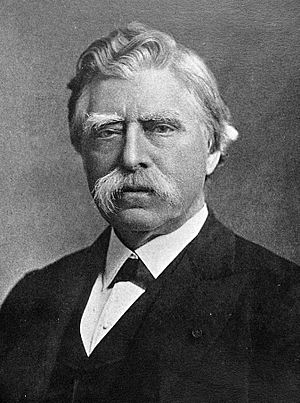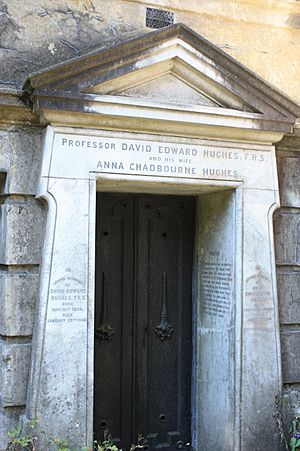David Edward Hughes facts for kids
Quick facts for kids
David Edward Hughes
|
|
|---|---|
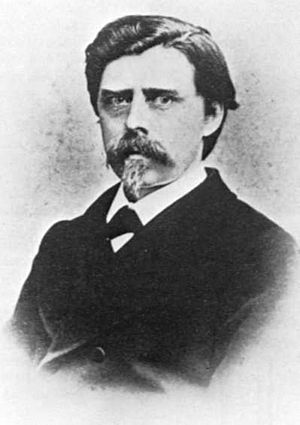
David Edward Hughes
|
|
| Born | 16 May 1830 London or Corwen, Denbighshire
|
| Died | 22 January 1900 (aged 68) London
|
| Nationality | British-American |
| Known for | Teleprinter, Microphone, Early radio wave detection |
David Edward Hughes (born May 16, 1830 – died January 22, 1900) was a talented inventor and experimenter. He was born in London, England, but his family moved to the United States when he was young.
Hughes became famous for inventing the printing telegraph and improving the microphone. He also likely discovered radio waves, long before they were officially proven to exist.
Contents
Biography of a Young Inventor
David Edward Hughes was born in 1830. His family was very musical. They moved to the United States when he was about seven years old. Even at age six, he played the harp and concertina very well.
He was so good at music that he became a music professor. This happened at St. Joseph's College in Kentucky. But Hughes also loved to experiment and invent things.
In 1855, he created his first big invention: the printing telegraph. He moved back to London in 1857. There, he continued to work on new ideas. He improved the microphone and developed the induction balance. This balance was later used in metal detectors.
The Printing Telegraph
In 1855, Hughes invented a new kind of printing telegraph. This machine could print messages directly onto paper tape. It was a big improvement over older telegraphs.
His invention was so good that many telegraph companies started using it. In the United States, several small companies joined together. They formed the Western Union Telegraph Company. They used Hughes's system for their business. In Europe, his telegraph became a standard way to send messages.
How Hughes Improved the Microphone
In 1878, Hughes shared his work on how sound affects electronic sound pickups. These pickups were called "transmitters" and were used in telephones. He showed that changes in the carbon parts of a telephone transmitter made it work. This was different from what most people thought.
Hughes called this discovery the "microphone effect." He used a word that had been made up earlier for a device that made sounds louder. He showed how it worked with a simple experiment. He put an iron nail across two other nails connected to a battery.
He made his microphone even better. He used several "carbon pencils" placed into carbon blocks. This design picked up sound very well. Hughes chose not to patent his invention. He believed it should be free for everyone to use and improve.
Discovering Radio Waves Early
David Hughes might have discovered radio waves nine years before they were officially proven. This happened in 1879 while he was working in London. He noticed something strange. A bad connection in a telephone he was using seemed to spark. He could hear this sparking in a separate microphone device nearby.
He improved his detector to pick up these unknown "aerial waves." He also found a way to make a series of sparks. He experimented and found he could pick up these waves from far away. He carried his telephone device up to 500 yards (about 457 meters) down the street!
On February 20, 1880, he showed his discovery to important scientists. These included members of the Royal Society in London. However, one scientist thought it was just electromagnetic induction. This is a different kind of electrical effect. Hughes was not a physicist, so he accepted this explanation. He did not continue his experiments.
It turns out Hughes was likely right. What he heard were probably radio transmissions. But the idea of electromagnetic radiation was not yet proven. It was only nine years later that Heinrich Hertz showed radio waves existed.
Hughes did not publish his findings at the time. But in 1899, he wrote a letter about them. He said that Hertz's experiments were "far more conclusive than mine." He also praised Guglielmo Marconi for his success in radio.
Hughes and the Royal Society
Hughes was recognized for his scientific work. He became a Fellow of the Royal Society in June 1880. This is a very important scientific group. He also won their Royal Medal in 1885.
After Hughes passed away, the Royal Society created the Hughes Medal in his honor. This medal is given to scientists who make important discoveries. Especially in areas like electricity and magnetism. The first Hughes Medal was given out in 1902.
Death and Legacy
David Hughes died in London on January 22, 1900. He was buried in a family vault at Highgate Cemetery. His wife, Anna Chadbourne Hughes, was buried with him.
In his will, Hughes left a large amount of money. He gave most of his property to a trust fund. This money was shared among four hospitals in London. He also left money to several scientific organizations. These included the Institute of Electrical Engineers and the Royal Society.
Awards and Honors
David Hughes received many awards for his inventions and discoveries:
- A Grand Gold Medal at the Paris Exhibition in 1867.
- The Royal Society gold Medal in 1885.
- The Society of Arts Albert Gold Medal in 1897.
- He was made a Chevalier of the Legion of Honour by Napoleon III in 1860. This is a very high honor in France.
He also received many other awards from different countries:
- The Order of Saints Maurice and Lazarus (Italy)
- The Order of the Iron Crown (Austria)
- The Order of Saint Anne (Russia)
- The Noble Order of Saint Michael (Bavaria)
- Commander of the Imperial Order of the Grand Cross of the Medjidie (Turkey)
- Commander of the Royal and Distinguished Order of Carlos III (Spain)
- The Grand Officer's Star
- Collar of the Royal Order of Takovo (Serbia)
- Officer of the Order of Leopold (Belgium)
Images for kids
See also
 In Spanish: David Edward Hughes para niños
In Spanish: David Edward Hughes para niños


